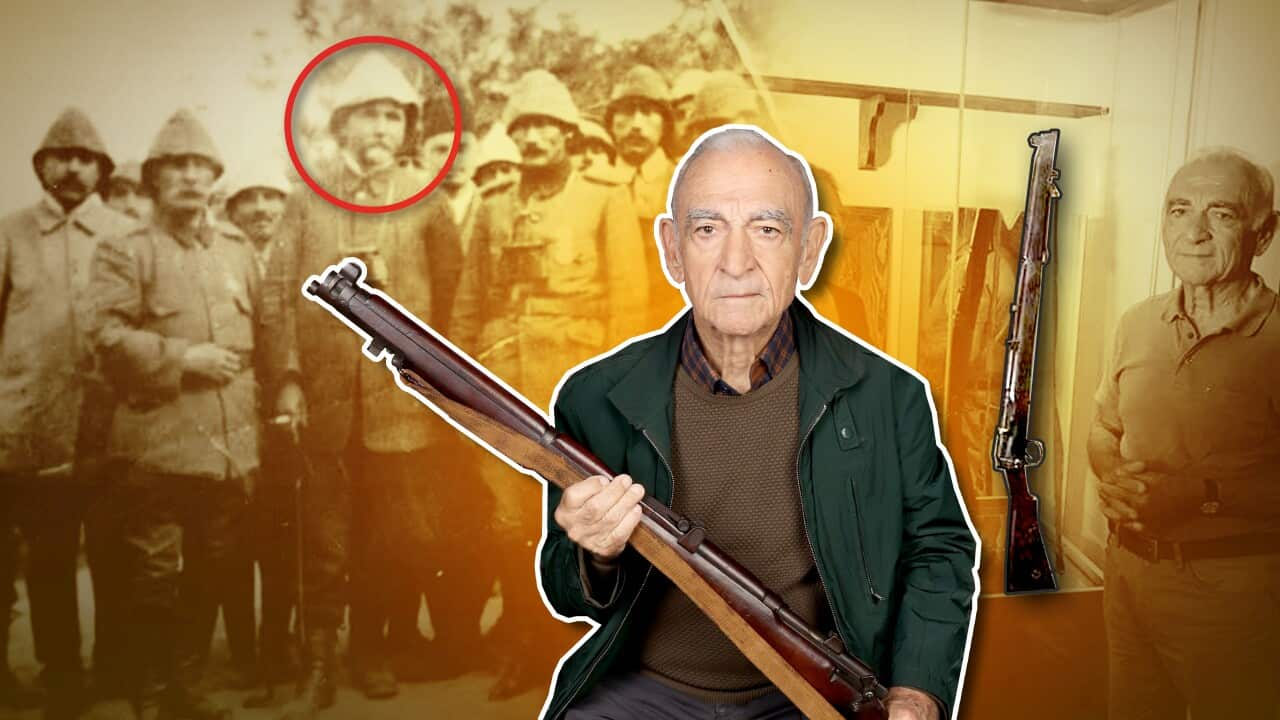Key Points
- Ömer Arda inherited the Anzac rifle from his father.
- It was exhibited for 18 months in a small museum near Gallipoli.
- Arda says he is willing to lend the rifle to the Australian government for exhibition.
A rifle belonging to an Anzac prisoner of war (POW) has been discovered among the possessions of a family in İstanbul, Turkey.
Experts from the Australian War Memorial (AWM) have examined photos of the engravings that appear on the rifle and have concluded that it belonged to a soldier from the New South Wales 1st Brigade, who took part in the Gallipoli campaign during World War One.
The identity of the soldier has yet to be established.
Almost 9,000 Australian soldiers died during the 1915 campaign while 26,000 were injured.
The campaign came to be known as Australia’s ‘baptism of fire’ as the tragic, large-scale loss of life cemented the country’s position in the world, 15 years after Federation.
Anzac soldiers during the military campaign which took place from 19 February 1915 to 9 January 1916. Credit: National Library of Australia
“The markings on the butt of the rifle indicate clearly that it was made in Lithgow in 1914, it is in wonderful condition,” AWM expert Garth O’Connell said.
“Unfortunately, we will never know who was issued this rifle as the temporary issue records made at the time were not retained.”
Ömer Arda, a retired architect, inherited the rifle from his father.
He told SBS Turkish the weapon was a gift to his grandfather, Hacı Adil Bey by the German commander of the Ottoman forces in Gallipoli, General Otto Liman Von Sanders.
“It has been in our family for generations,” Arda said.
Hacı Adil Bey and Liman Von Sanders. Source: Supplied / Ömer Arda
Hacı Adil Bey was one of the founders of the Committee of Union and Progress (CUP), a political organisation of the Turkish social, political and military elite.
He also served as the governor of the Edirne Province, which encompassed the Gallipoli war zone.
“There was tension between the CUP leadership and Mustafa Kemal (Atatürk), founder of modern Türkiye and Gallipoli war hero,” Arda explained.
“The CUP asked my grandfather to visit Kemal at the Gallipoli front as a mediator and talk to him to ease tensions.”
Hacı Adil Bey visited the Gallipoli front on May 16, 1915, less than a month after the Anzac landing, spending two days with Kemal.
Hacı Adil Bey also visited General Von Sanders, as it wouldn’t have been appropriate not to, Arda said.
According to Arda, Turkish soldiers had brought the Anzac rifle to Kemal in the days following the landing.
He signed it before gifting it to General Von Sanders, who also signed it – the two signatures are still visible on the rifle’s wooden stock.
It’s believed that the item was then presented to Hacı Adil Bey, with the knowledge that it belonged to one of the first Anzac POWs, and that it would be better for the item to remain in Turkey rather than if he took it back to Germany at the end of General Von Sanders’ tour.
Hacı Adil Bey’s visit to Mustafa Kemal (Atatürk) at the front in Gallipoli on May 16, 1915. Credit: Ömer Arda
Turkish Australian military historian Professor Mesut Uyar said the gifting of signed weapons of enemy soldiers to high-ranking officials was a common practice during World War One.
“The most famous is the British rifle given to Lawrence of Arabia which is now exhibited at the British War Museum,” he said.
Rifle rarely seen
The Arda family’s Anzac rifle has only been seen in public twice in 108 years.
It was displayed in a small museum in Gallipoli in 2018.
When Gallipoli Historical Field Department staff visited Arda to collect the rifle, he was “amazed” as it was transported by police to Gallipoli.
The museum was located in the village of Bigali – which had been used by Kemal as his headquarters for six days during the Gallipoli campaign.
It was displayed in a purpose-made glass cabinet for 18 months.
“I don’t think any Australian visitors go there because it is not close to Arı Burnu which is popular for Australians and New Zealanders,” said Serpil Savaş, an art historian at the Gallipoli Historical Field Department.
Arda confirmed the rifle was “sent back to me because the museum was nervous about potential theft”.
Ömer Arda (R) and his sister travelled to Bigalı in 2018 for the opening of the exhibition where their family’s Anzac rifle was exhibited for 18 months. Credit: Ömer Arda
The rifle was also on show in 1960, albeit for a couple of hours.
Arda explained that after the military coup in Türkiye that year, the junta asked citizens to surrender their weapons to the authorities.
“My law-abiding father took the rifle to the closest police station to surrender (it) but the commander of the station refused to take it and sent him back home after hearing the story and recognising its historical value,” he said.
“The police commander told my father, ‘you haven’t brought this rifle here and I haven’t seen it’. Other than that, the rifle has been moved from one cupboard to another when we moved house, for more than 100 years. It was never exposed to daylight.”
Arda said he would be happy for the item to go on exhibition in Australia if the relevant authorities expressed interest in doing so.




